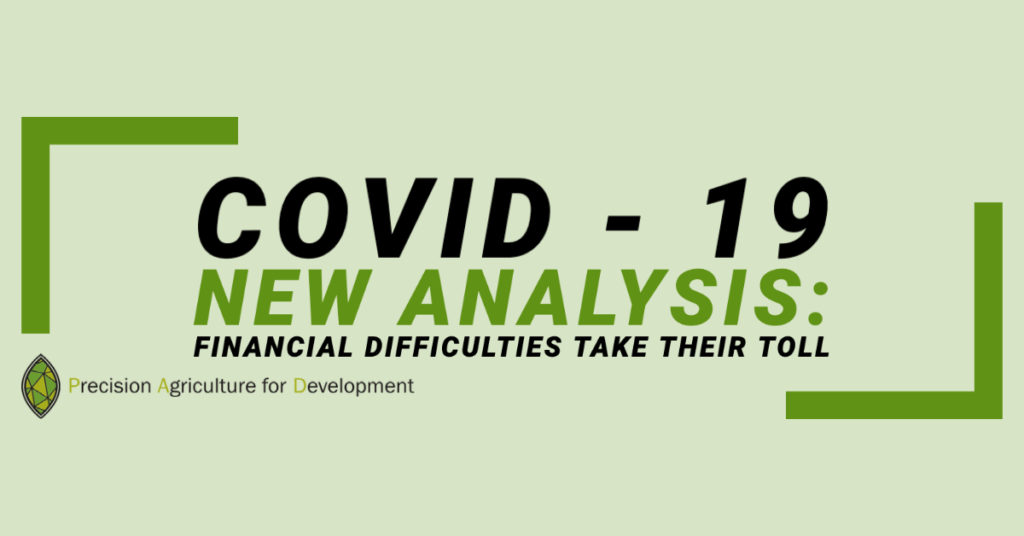On-going Distress: COVID-related Financial Difficulties Impact Farmers and Agro-dealers in Rural Kenya
- March 1, 2021
- 11 minutes read
Sam Strimling, a Research Associate on PAD’s Kenya team, reflects on the results of a third round of interviews surveying farmers and agro-dealers across Kenya’s agricultural heartland.

CONTEXT
In December 2020, Precision Agriculture for Development (PAD) interviewed 509 crop farmers and 274 agro-dealers registered on the MoA-INFO SMS platform in Kenya. This survey was the third and final round of a panel survey, of which the first round took place between late April and early June 2020, and the second took place from August to early September 2020.The first two rounds of surveys focused on the long rainy season, which is the main agricultural season in Kenya, and the third round examined the short rainy season. Data from all three survey rounds are visualized on our COVID-19 Dashboards.
During the survey period, COVID-19 continued to spread globally and in Kenya. Since the first reported case in Kenya on March 13, according to statistics collated by the World Health Organization, as of February 2, 2021, there have been 100,773 confirmed cases in Kenya, and 1,763 COVID-related deaths.
By the time of the survey, restrictions to mobility and social interaction that had been imposed in March and April in an effort to slow the spread of the virus had been relaxed: A nightly 7pm-5am curfew, first imposed on March 27, was revised to 9pm-4am on June 7. On April 6, a lockdown was imposed on Nairobi, which eventually covered five counties (Nairobi, Mombasa, Kilifi, Kwale, and Mandera). As of July 7, restrictions on movement other than curfew were lifted. Domestic flights also resumed on July 15, and international flights resumed August 1.
SAMPLE CHARACTERISTICS
In order to track the evolving economic and social effects of COVID-19 with the same population over time, across all rounds, we interviewed 1,471 farmers and 735 agro-dealers.
While individual respondents differed slightly across the three survey rounds, the demographics of the survey group remained similar. The below charts summarize select demographic information for both the farmer and agro-dealer surveys:
| Round | Total respondents | Counties represented | % male | Avg. age | % who grew maize as their primary crop |
| Round 1 | 973 | 44 | 58% | 41 | 79% |
| Round 2 | 974 | 44 | 57% | 42 | 80% |
| Round 3 | 509 | 42 | 56% | 44 | 53% |
The major difference in the farmer demographics across rounds is the percentage of farmers growing maize as a primary crop. It appears a large share of farmers grew beans rather than maize in R3, with 17% of R3 respondents reporting beans as their primary crop — up from 4% in R2. This makes sense in light of the larger seasonal context: farmers tend to focus on maize production during the long rainy season but diversify their crops during the short rainy season.
| Round | Total respondents | Counties represented | % male | Avg. age | Avg. annual sales (2019) | Avg. number of employees |
| Round 1 | 483 | 40 | 68% | 46 | US$11,351 | 2.2 |
| Round 2 | 427 | 40 | 72% | 45 | US$11,348 | 1.8 |
| Round 3 | 274 | 35 | 71% | 46 | US$10,564 | 1.5 |
In an effort to build a panel dataset to track change over time, we prioritized contacting farmers who had participated in our earlier surveys. Respondents who participated in R1 and/or R2 were prioritized; all R1 and R2 respondents were called three times before new respondents were called. Of the farmers interviewed in Round Three (R3), 70% participated in Round Two (R2) and 53% participated in Round One (R1). Of the agro-dealers interviewed in R3, 57% participated in R2 and 55% participated in R1.
FINDINGS
Farmers’ expectations for the previous (2020 long rainy) season were not been met, and farmers anticipated difficulties in purchasing sufficient inputs for the upcoming (2020 short rainy) season
Fifty-eight percent of R3 farmers reported a lower yield relative to the 2019 long rainy season, belying expectations expressed in R2 and R1 when 49% and 52% of farmers, respectively, said they expected a larger harvest relative to the previous year due to good rains and, reportedly, improved farming practices. The reasons cited by farmers in R3 for lower observed harvest were varied: 29% of farmers with a lower observed harvest in the 2020 long rainy season attributed this to excessive rains, with another 24% citing insufficient rain. Additionally, 24% explained that they had used fewer inputs. This makes sense given that 76% of R2 farmers anticipated difficulties purchasing sufficient inputs for the impending short rainy agricultural season, with 66% reporting they did not have enough money to do so.
Furthermore, of the 42% of R3 farmers who had sold all or some of their harvest from the long rainy season, 58% reported receiving a lower price versus the previous year. This again conflicted with the expectations of R2 and R1 farmers, of whom 58% and 66%, respectively, reportedly expected a higher price compared to the 2019 long rainy seasons. The primary perceived cause for dashed expectations appeared to be supply outstripping demand, with R3 farmers who received a lower price for harvest sold citing both higher market supply (43%) and fewer buyers (34%).
Still, expectations for the upcoming short rainy season were much more mixed, with 42% of farmers anticipating a lower harvest and 39% anticipating a higher harvest. These expectations in turn depended on those about rainfall: both the plurality of farmers who expected low harvests, as well as those expecting large harvests, cited rainfall as justification for these expectations. Price expectations in turn depended on expectations about supply: of the 54% of farmers who reported expecting a higher price for their forthcoming harvest, 60% attributed this to low production/market supply. Similarly, of the 31% of farmers reportedly expecting a lower selling price, 60% attributed this expectation to high production/market supply.
However, 80% of R3 farmers anticipated difficulties purchasing inputs for the 2021 long rainy season, a concern 62% attributed to lack of resources. In this way, R3 expectations were a continuation of earlier trends. Agro-dealers confirmed that prices were higher, with 62% of those interviewed in R3 reporting they had increased the prices charged to farmers relative to the same season previous year. This, too, was in line with earlier rounds: 65% of agro-dealers surveyed in R1 and 55% of those surveyed in R2 reported year-on-year price increases for the same set of inputs. However, with agro-dealers facing financial troubles themselves, the only way to stay in business may be through the practice of passing on high prices from suppliers, which have also increased according to 71% of agro-dealers interviewed in R3. Across all rounds, agro-dealers were statistically more likely (at the 1% level) to report charging farmers higher prices if the prices charged to them by suppliers had increased. Farmers’ inability to secure the necessary inputs may in part account for low harvest (and, consequently, high sale price) expectations for the season.
That said, agro-dealers are optimistic about their ability to satisfy the needs of the farmers who did attempt to buy from them: only 8% of R3 agro-dealers anticipated that they would be unable to meet farmer demand, compared with 26% in R2 and 29% in R1. The largest concern — cited by 71% of those in R3 who predicted they would be unable to meet farmer demand — was having insufficient resources to do so.
Continued food shortages and financial distress, relative to 2019
On a positive note, farmers experienced improved household consumption patterns compared to previous rounds, as they adapted to changing circumstances and as restrictions on mobility were lifted. Additionally, some of the improvement in consumption may be due to seasonal changes, as 42% of R3 farmers reported selling at least some of their seasonal harvest from the long rainy season, which means they likely have more cash on hand for household purchases. In R3, 62% of farmers reported difficulties buying food due to market changes over the past week – down from 71% of farmers in R2 and 87% in R1. Additionally, only 28% of farmers reported difficulty accessing markets over the past week due to mobility restrictions. This is just under half of the number who reported this issue in R2 (44%), which was in turn down versus 48% in R1. In further good news, over the past week, significantly fewer farmers in R3 reported reducing the number or size of household meals, reducing the amount of food purchased due to reduced income, and changing their diet composition. (Refer to the table below for the relevant statistics.)
That said, farmers still experienced significant distress compared to before the pandemic. In December 2019, just 8% R3 respondents reported difficulties buying food due to market changes, 5% reported mobility restrictions, 18% reported difficulties purchasing food due to reduced income, 16% reported reducing the size and/or number of meals, and 16% reported changing their diet composition.
| Experience | Dec. 2019 | May 2020 (R1) | Aug. 2020 (R2) | Dec. 2020(R3) |
| Difficulty purchasing food due to market changes | 8% of respondents | 57% of respondents | 47% of respondents | 21% of respondents |
| Difficulty going to the market due to mobility restrictions | 5% | 48% | 44% | 28% |
| Difficulty purchasing food due to reduced income | 18% | 63% | 70% | 51% |
| Reduced number and/or size of meals | 16% | 46% | 62% | 49% |
| Changed composition of meals | 17% | NA | 65% | 53% |
Business as (new) usual?
In an effort to adapt to changing circumstances, agro-dealers across all three rounds made changes to stocking, sales, and operations. Compared with R1 agro-dealers, R2 agro-dealers were statistically more likely to make changes across all three categories, and R3 agro-dealers were statistically more likely to make changes to sales and operations versus R2 agro-dealers. They were also slightly more likely to report making changes in stock, although this result was not statistically significant. (Refer to the below table for the relevant statistics.) These trends suggest changes to the business were imperative for long-term survival.
However, while agro-dealers may have reached a new normal in their stocking practices, sales, and operations, business has not returned to pre-pandemic levels. Instead, agro-dealers face serious economic headwinds and a difficult business environment. R3 agro-dealers were statistically more likely than R2 agro-dealers to report lower expected footfall, lower observed sales, and lower expected sales. Fifty-four percent of R3 agro-dealers who observed low footfall attributed this to insufficient resources and the same proportion gave the same reason for low sales. At this stage, respondents perceived the prolonged economic slowdown to present a larger obstacle than government-imposed restrictions or public health precautions.
| Experience | Round 1 | Round 2 | Round 3 |
| Stock changes | 31% of agro-dealers | 53% of agro-dealers | 56% of agro-dealers |
| Sales changes | 29% | 54% | 77% |
| Operations changes | 63% | 71% | 86% |
Specifically, in Round 3, 25% of all respondents reported reducing stock and 22% reported and implementing cashless/electronic transactions with their suppliers as a means of coping with the pandemic. Thirty-five percent of agro-dealers also reported implementing cashless/electronic transactions with farmer-customers. The largest changes to sales, however, were increased hygiene measures (handwashing stations, wearing gloves, etc.), undertaken by 51% of agro-dealers, and social distancing, performed by 39% of agro-dealers. Similarly, 62% of agro-dealers reported encouraging handwashing and 51% reported enforcing social distancing as key changes to operations. With the increasing implementation of these measures — and the relaxation of the nationwide curfew and mobility restrictions — agro-dealers were able to resume their pre-pandemic shop hours in R2 and continue through R3.
Additionally, as farmers adapted to the changing conditions, initially differential reactions by gender appear to have converged. In R1, female crop farmers were statistically more likely than their male counterparts to report that household members were spending fewer days on their own farms and paying higher prices for fertilizer (relative to the previous year); this was not the case in R2. However, in both R1 and R2, female crop farmers were significantly more likely than their male counterparts to report that they had had to rely on assistance from family to cover living expenses and were more likely to report having to reduce the size or number of meals served in the 30 days prior to being surveyed. Yet, by R3, there were no statistically significant differences by gender in measurements of production or consumption.
RECOMMENDATIONS
In R3, we asked farmers and agro-dealers directly which interventions or services could help them adjust to ongoing changes in the business environment associated with the pandemic. The purpose of this question was to inform program design not only for PAD, but also for other NGOs, government actors, and other stakeholders in the development community at large.
Our recommendations, informed by respondents’ preferences, fall into three buckets:
- Direct and indirect financial assistance: Unsurprisingly, given the reportedly difficult business environment, 18% of agro-dealers requested direct financial assistance and an additional 16% requested help acquiring inputs affordably. Similarly, 19% of farmers asked for provision of inputs, or requested particular inputs.
- Targeted advisory messages: Both agro-dealers and suppliers expressed a need for additional information. Twenty percent of farmers and 9% percent of agro-dealers requested general farming information, with an additional 7% of agro-dealers requested public health information. More specifically, when farmers were asked to rank proposed interventions pre-selected by PAD for their feasibility and mission alignment, many seemed eager to make the most of their limited funds: 31% chose as their first choice “information on soil testing,” while 27% ranked recommendations on less capital-intensive practices as a first priority.
- Improved market linkages: The plurality of agro-dealers (34%) ranked first “more information from farmers about input preferences,” suggesting a desire to improve market linkages. Along the same lines, the vast majority (96%) indicated they would be willing to share their contact information with interested farmers. Additionally, 91% of agro-dealers expressed a willingness to switch suppliers if a better price was offered. Given the trickle-down effect of supplier prices on the entire supply chain, providing agro-dealers with information and/or communication channels needed to improve their sourcing would help them stay in business while enabling them to meet farmers’ needs.
This research was funded by the COVID-19 Adaptation Fund, a joint initiative between the Global Development Incubator (GDI) and Instiglio. The aim of the Adaptation Fund is to collect data and find innovative solutions for service providers like PAD that serve vulnerable populations disproportionately impacted — socially and economically — by COVID-19.

Stay Updated with Our Newsletter

Make an Impact Today


